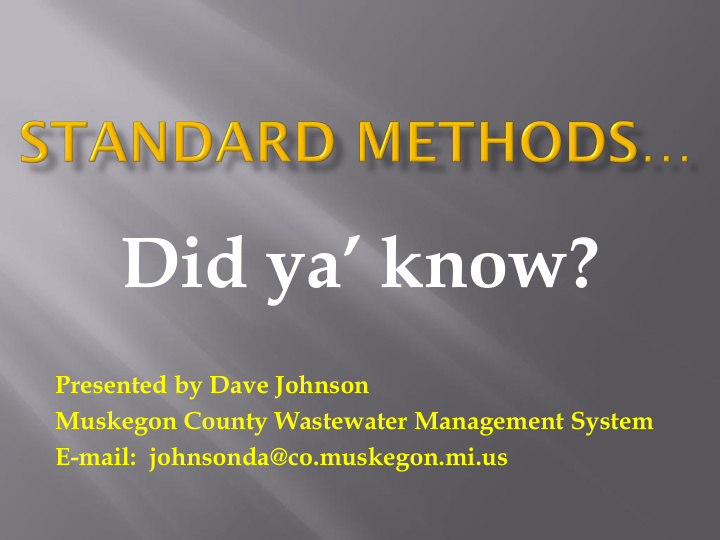



Did ya ’ know? Presented by Dave Johnson Muskegon County Wastewater Management System E-mail: johnsonda@co.muskegon.mi.us
www.federalregister.gov
If your lab uses Standard Methods Online edition, you’re golden.
Fecal Coliform (MPN) Total Phosphorus Fecal Coliform (mFC) COD Ammonia Oil and Grease BOD/CBOD Metals by Flame AA pH Metals by GFAA Residual Chlorine Metals By ICP DO Metals by ICP-MS TSS/VSS Hg by CVAA Temperature Total Cyanide Hardness Total Phenols
www.standardmethods.org/ PDF/EPA_Acceptable_ Version_WW_6-20-2012 _final.pdf
Fecal Coliform (MPN) Total Phosphorus Fecal Coliform (mFC) COD Ammonia Oil and Grease BOD/CBOD Metals by Flame AA pH Metals by GFAA Residual Chlorine Metals By ICP DO Metals by ICP-MS TSS/VSS Hg by CVAA Temperature Total Cyanide Hardness Total Phenols
Fecal Coliform (MPN) Total Phosphorus Fecal Coliform (mFC) COD Ammonia Oil and Grease BOD/CBOD Metals by Flame AA pH Metals by GFAA Residual Chlorine Metals By ICP DO Metals by ICP-MS TSS/VSS Hg by CVAA Temperature Total Cyanide Hardness Total Phenols
Fecal Coliform (MPN) Total Phosphorus Fecal Coliform (mFC) COD Ammonia Oil and Grease BOD/CBOD Metals by Flame AA pH Metals by GFAA Residual Chlorine Metals By ICP DO Metals by ICP-MS TSS/VSS Hg by CVAA Temperature Total Cyanide Hardness Total Phenols
Fecal Coliform (MPN) Total Phosphorus Fecal Coliform (mFC) COD Ammonia Oil and Grease BOD/CBOD Metals by Flame AA pH Metals by GFAA Residual Chlorine Metals By ICP DO Metals by ICP-MS TSS/VSS Hg by CVAA Temperature Total Cyanide Hardness Total Phenols
New criterion for incubation time:
New criterion for incubation time: 5 Days ± 6 Hours (Section 5, Part i)
New requirement for the Glucose-Glutamic Acid Check (GGA)
Set up THREE GGA samples. The average Measured BOD of the three samples must be 198 ± 30.5 mg/L (Section 6, Part b)
New instructions for determining the detection limit for a sample.
For samples with NO SEED and NO DILUTION : The detection limit equals the detection limit of the DO measurement method. ( i.e., around 0.1 mg/L) (Section 8, Part b)
For samples with NO SEED but which ARE DILUTED : The detection limit equals 2 mg/L multiplied by the dilution factor. (Section 8, Part b)
For samples which are SEEDED and DILUTED : The detection limit equals 2 mg/L minus the seed correction, multiplied by the dilution factor. (Section 8, Part b)
For samples which are SEEDED and DILUTED , the actual text does not say to multiply by the dilution factor. However, common sense would dictate otherwise.
For samples which are SEEDED but NOT DILUTED : The detection limit is 0 mg/L. (Section 8, Part b)
DO by Winkler & DO by Membrane Electrode
New Minimum QC Requirements
Sample Duplicate (T ABLE 4020:I. M INIMUM Q UALITY C ONTROL FOR M ETHODS IN P ART 4000)
Zero Check with Zero Oxygen Sample (T ABLE 4020:I. M INIMUM Q UALITY C ONTROL FOR M ETHODS IN P ART 4000)
How do you prepare a Zero Oxygen Sample? SM gives a vague recipe:
“Add excess sodium sulfite, Na 2 SO 3 , and a trace of cobalt chloride, CoCl 2 , to bring DO to zero.” (SM 4500-O G-2001, Section 3, Part a)
20 g sodium sulfite, Na 2 SO 3 10 mg cobalt chloride, CoCl 2 (a few crystals) 1 L water Dissolve with stir bar and stir plate. Good for 8 hours.
1 g sodium sulfite, Na 2 SO 3 10 mg cobalt chloride, CoCl 2 (a few crystals) 1 L water Dissolve with stir bar and stir plate. Good for 30 min., maybe longer.
Carefully pour the standard into a BOD bottle up to the neck. Add your Winkler reagents and titrate.
Carefully pour a portion of the standard into a beaker to attain a depth of 2 to 3 inches. Submerge the DO probe so that the tip is near the bottom of the beaker. Swirl gently and read.
One manual for a Thermo membrane electrode meter says that the probe must be inserted in the zero standard for at least 5 minutes. Another says 2.5 minutes.
There are some surprises in store for you when you explore the new versions of the Standard Methods methods.
Recommend
More recommend